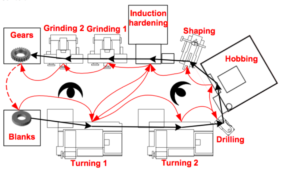Flow manufacturing is key component of Lean manufacturing and Toyota Production System. Flow manufacturing plays a vital role in throughput time reduction and elimination on non value adding activities through Kaizen.
There are seven key requirements for Flow manufacturing:
1. Continuous flow production line: This means arranging the production processes (and the production equipment) into a line or a U-shaped cell. To implement continuous flow or cellular manufacturing, you must learn concept of takt time and line balancing
2. Compact specialized and general-purpose equipment: Costs can be kept down by installing smaller, slower, and
more specialized production equipment. However, some general-purpose equipment is also needed to facilitate flexible line reorganization. Elephant or large equipmemt may look attractive, as they can handle a lot of products at a

time, but are a big obstruction to flow because inventory will always accumulate at these equipments
3. One-piece flow: This means that each process should handle only one
workpiece unit from the time processing of that work-piece is begun until it is finished. One piece flow is generally most difficult to achieve in flow manufacturing but yields highest results. Yamazumi charts and standard work are key tools to achieve one piece flow
4. Cycle time : This refers to the need to synchronize processes to keep pace with client needs and the needs of the next process. Cycle times must always be balanced to TAKT time to support flow manufacturing
5. Multi-process handling : This is a labor arrangement in which one worker moves
from process to process down the line and handles multiple processes.
6. Multi-skilled workers : This entails training workers in the skills needed for
multi-process handling. To achieve mutli skilling, skill matrix and tools like TWI ( Training within industry) are key
7. Standing (chair-free) operations : An important improvement in work posture is changing from sitting to standing, enabling worker mobility. Standing operation is generally a big challange in african and asian countries, where people are psychologically confortable in sitting operations. It takes lot of commitment, conducting trials, education and motivation schemes to implement standing operations

